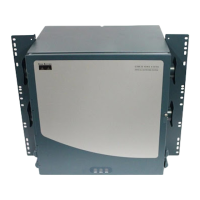17-75
Cisco ONS 15454 Procedure Guide, R5.0
March 2005
Chapter 17 DLPs A1 to A99
DLP-A69 Set Up External or Line Timing
Step 2 In the Preferences dialog box, click the Firewall tab.
Step 3 In the CTC CORBA (IIOP) Listener Port area, choose a listener port option:
• Default - Variable—Select this option if the ONS 15454s are on the same side of the firewall as the
CTC computer or if no firewall is used (default). This option sets the CTC listener port to
Port 57790. It can be used for access through a firewall if Port 57790 is open.
• Standard Constant—Select this option to use Port 683, the CORBA default port number, as the
CTC computer listener port.
• Other Constant—If Port 683 is not used, enter the IIOP port defined by your administrator.
Step 4 Click Apply. A warning appears telling you that the port change will apply during the next CTC login.
Step 5 Click OK.
Step 6 In the Preferences dialog box, click OK.
Step 7 To access the ONS 15454 using the IIOP port, log out of CTC then log back in. (To log out, choose Exit
from the File menu).
Step 8 Return to your originating procedure (NTP).
DLP-A69 Set Up External or Line Timing
Step 1 In node view, click the Provisioning > Timing > General tabs.
Step 2 In the General Timing area, complete the following information:
• Timing Mode—Choose External if the ONS 15454 derives its timing from a BITS source wired to
the backplane pins; choose Line if timing is derived from an OC-N card that is optically connected
to the timing node. A third option, Mixed, allows you to set external and line timing references.
Note Because Mixed timing might cause timing loops, Cisco does not recommend its use. Use this
mode with care.
• SSM Message Set—Choose a synchronization status messaging (SSM) message set. All
ONS 15454s can translate Generation 2 message sets, so choose Generation 2 if the ONS 15454 is
connected to other ONS 15454s. Choose Generation 1 only when the ONS 15454 is connected to
equipment that does not support Generation 2. If a node that has a Generation 1 SSM message set
receives a Generation 2 message, it maps the message down to the next available Generation 1
message. The transit node clock (TNC) and ST3E (Stratum 3E) will become an ST3 (Stratum 3).
Purpose This task defines the SONET timing source (external or line) for the
ONS 15454.
Tools/Equipment None
Prerequisite Procedures DLP-A60 Log into CTC, page 17-66
Required/As Needed Required
Onsite/Remote Onsite or remote
Security Level Provisioning or higher

